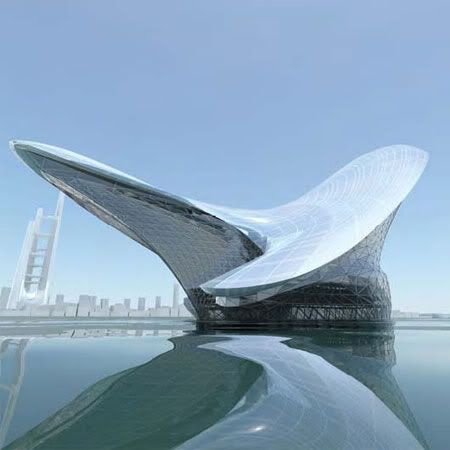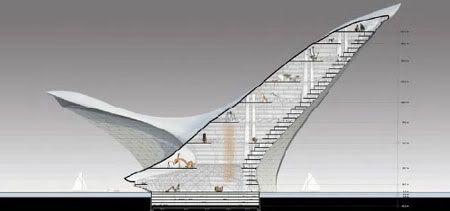
A simple but arresting image from nature—a bird skimming over the surface of a body of water—was the inspiration for this prototype of a museum on a lake or ocean harbor. With its wings unfurled as if in midflight, this powerfully poetic structure is an evocation of the natural world at its most graceful, dynamic, streamlined and ecologically interdependent.
Wings Museum
Design Team: Adrian Smith + Gordon Gill Architecture LLP
Location: Suitable for a lake or ocean harbor
When to visit: Currently a prototype only.
That inspiration, combined with concepts from automobile and product design, has been developed into a sculptural, asymmetrical form echoed in its interior by two great atria that feel equally organic. Appropriately, given its nature imagery, the building is highly sustainable. Covered with photovoltaic cells, the entire roof structure protects the underside of the building from the harshest sunlight. That, in turn, allows for a more transparent curtain wall, which features a graduated frit pattern based on the building’s structural geometry.
Design Team: Adrian Smith + Gordon Gill Architecture LLP
Location: Suitable for a lake or ocean harbor
When to visit: Currently a prototype only.
That inspiration, combined with concepts from automobile and product design, has been developed into a sculptural, asymmetrical form echoed in its interior by two great atria that feel equally organic. Appropriately, given its nature imagery, the building is highly sustainable. Covered with photovoltaic cells, the entire roof structure protects the underside of the building from the harshest sunlight. That, in turn, allows for a more transparent curtain wall, which features a graduated frit pattern based on the building’s structural geometry.


The elegance of the building’s form is made possible by its complex structure, which involves a system of belt trusses and large columns necessary to support cantilevers of up to 100 meters. A grid of exterior steel members is mirrored inside the building, creating a tube-within-a-tube. The interior diagrid allows the floor plan to be supported with simple spans and achieves a column-free interior space.
The tension face of the structure is reinforced by a belt truss, which occurs at each floor to resist forces that would pull the surface flat, and it provides a support edge for the long-span trusses supporting the interior atrium floors.
The building has about 1.5 million square feet of floor space, with an apex of about 200 meters.







via AS+GG
The tension face of the structure is reinforced by a belt truss, which occurs at each floor to resist forces that would pull the surface flat, and it provides a support edge for the long-span trusses supporting the interior atrium floors.
The building has about 1.5 million square feet of floor space, with an apex of about 200 meters.







via AS+GG
No comments:
Post a Comment